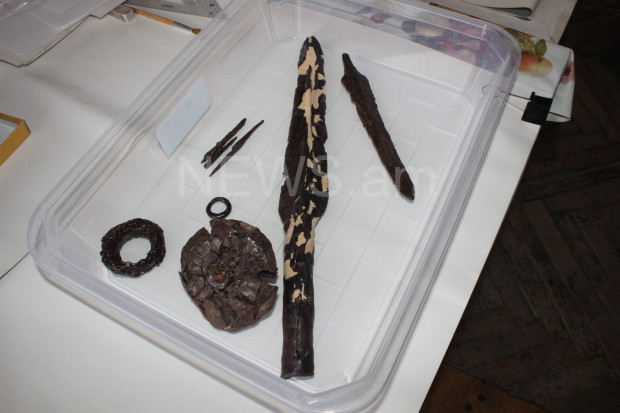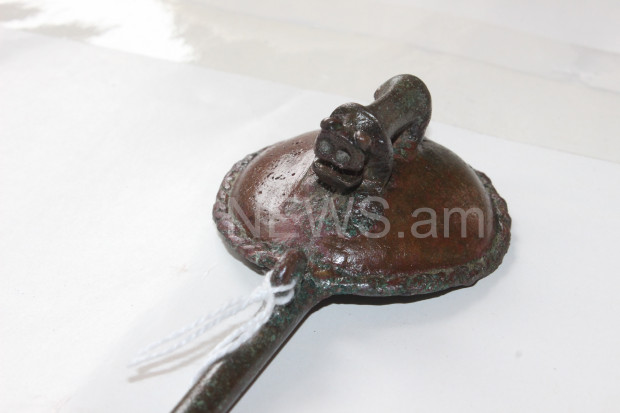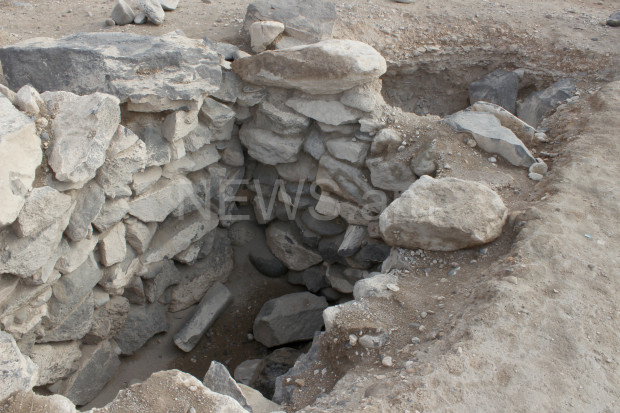The area near the cemetery Shengavit, on the outskirts of Yerevan, is unlikely to attract the attention of passers-by. This location is near the ruins of the Urartu fortress town Teishebaini located on Karmir Bloor hill, which has been used since the 90s as a city dump.
In 2010-2011, the Union of Architects during the meeting devoted to the issues related to the construction of a highway passing through that area, concluded that this area was no longer of any interest to archaeologists. However, the director of the research center of cultural heritage under the Ministry of Culture Hakob Simonyan did not agree with that opinion and insisted on conducting an examination in that area, which at that time seemed to be a waste of time.
In 2013, after 40 sq. m. area had been cleaned up from the waste accumulated for years, archaeologists began their work. The results were not long in coming: soon they discovered necropolis Teishebaini. "It was a major discovery, since the expedition of Boris Piotrovsky found about a dozen tombs years ago, but the question of the location of the necropolis of the walled city remained open," said Hakob Simonyan in an interview with Armenian NEWS.am.
Large-scale excavations began in the summer of 2015. Archeologists had a difficult task: to finish excavations before the start of construction works planned for December. "We developed a special methodology for excavation works. Within a short period, we managed to dig out 300 tombs. Today we can surely say, that no single burial is left in that territory. We managed to excavate them all,” said Simonyan.
One of the most important foundlings is the tomb of a high official, presumably, the governor of the tsar. The reason for this view is that there was found a rod with a knob in the form of a bull and a crescent tip. Such rods were common belongings of Hittite, Assyrian kings, and Egyptian pharaohs.
According to Simonyan, Urartu (Kingdom of Van) perhaps had administrative-territorial divisions, with their own governors in each administrative unit. And, Teishebaini was the residence of one of them.
In total, more than 1,000 skeletons have been discovered during the excavations. “This is the largest anthropological collection of Armenia,” Simonyan noted, “thanks to which it will be possible to find answers to many questions, the scientists face.”
“Skulls have different shapes - round and elongated. This suggests that there lived different peoples in Van. However, the ones who dominated had round shaped skulls, which means that it was not settlers but aborigines who inhabited Teishebaini. It is noteworthy, that the knees of the skeletons discovered were bent. Women were buried lying on their left side, whereas men on their right side. In addition, there were many slaves in Teysheybani. They were often interred with their masters to serve them in the afterlife. The servants at that time were believed to be walking instruments. Thus, people did not see any problem of sacrificing them, " said Simonyan.
Archaeologists were much surprised to find graves of children, since it is known, that in ancient societies a child was considered a full-fledged member of the community only after becoming six years old. “Excavations were carried out at such a high level,” he added, “that we even managed to dig out an embryo. The woman probably died before or during the child delivery and was buried with the embryo.”
The bones of sacrificial animals, weapons, jewelry, all kinds of household utensils were found in tombs. The total number of discovered artefacts is several thousand. This collection will help get an idea of how the ancient inhabitants of Teishebaini dressed, what kind of funeral rites they had, what they ate, and even what diseases they had.
"The most common decorations were necklaces and bracelets. Their number depended on the social status of a woman. Sometimes a woman wore 5-6 bracelets, so that they rang in a dance and attracted more attention, " said Simonyan.
However, of the upmost importance, according to Simonyan, is that the discovered artifacts can bring clarity to which civilization and culture the inhabitants of Teishebaini, which was founded by king Rusa II, belonged to. For this, it is necessary to make DNA tests of ancient skeletons and compare these data with the DNA of modern Armenians. Some samples from the graves have already been sent to the laboratories in Copenhagen and Boston.
"Think of this, what if the tests reveal, that we have similar or the same genetics? In this case, all the rumors that Urartu is not related to Armenia will cease, " concluded Simonyan.
However, a complete investigation of all the anthropological materials from Teishebaini graves might cost several thousand dollars. Scientists rely on the support of the state or sponsors in this issue, as this study is of great importance not only for the history of Armenia but also for the entire world.
.JPG)

.JPG)



































